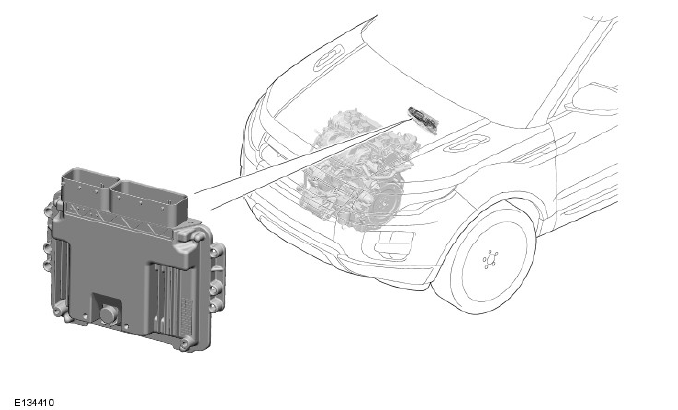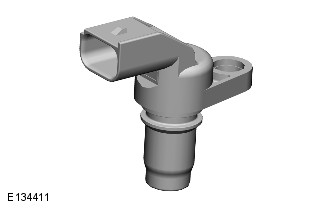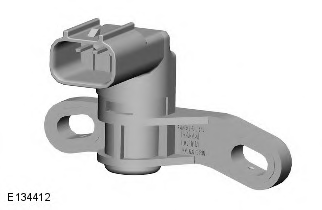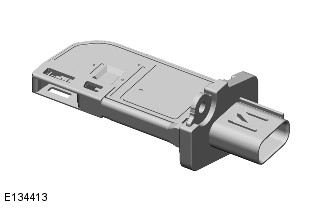Range Rover Evoque: Component Description
DESCRIPTION
Engine Control Module (ECM)

The ECM is located at the rear of the engine compartment, between the bulkhead and the engine sound insulation. The ECM is located in a plastic molded carrier which in turn is located in a bracket attached to the vehicle structure.
The ECM is connected to the vehicle harnesses via 2 connectors. The ECM contains data processors and memory microchips. The output signals to the actuators are in the form of ground paths provided by driver circuits within the ECM. . Some output signals take the form of high side drive signals. The ECM driver circuits produce heat during normal operation and dissipate this heat via the ribbed casing.
The ECM performs self diagnostic routines and stores fault codes in its memory. These fault codes and diagnostics can be accessed using a Land Rover approved diagnostic system.
If the ECM is to be replaced, the new ECM is supplied 'blank' and must be configured to the vehicle using a Land Rover approved diagnost c system. A 'flash' EEPROM (electrically erasable programmable read only memory) allows the ECM to be externally configured, using a Land Rover approved diagnostic system, with market specific or new tune. The current engine tune data can be accessed and read using a Land Rover approved diagnostic system. When a new ECM is fitted, it must also be synchronized to the CJB using a Land Rover approved diagnostic system. ECM's cannot be 'swapped' between vehicles.
Camshaft Position (CMP) Sensors

Two CMP sensors are used; one for the inlet camshaft and one for exhaust camshaft. The sensors are located on the top of the camshaft cover and are each sealed with an O ring seal and secured with a bolt to the cover.
The sensors are Hall effect sensors which read off a target on each camshaft. Each sensor receives a 5V reference voltage from the ECM. Two further connections to the ECM provide ground and signal output. The ECM uses the signals from the CMP sensors and the CKP sensor to determine current camshaft position and camshaft adjustment.
If a fault occurs with one or both CMP sensors, a DTC (diagnostic trouble code) is registered in the ECM. Two types of failure can occur; camshaft signal frequency too high or total failure of the camshaft signal. The DTC recorded by the ECM can also relate to a total failure of the crankshaft signal or crankshaft signal dynamically implausible. Both components should be checked to determine the cause of the fault.
If a fault occurs with a CMP sensor when the engine is running, the engine will continue to run. Once the engine is sw tched off, the engine will crank and restart while the fault is present, but VCT control will be disabled.
Crankshaft Position (CKP) Sensor

The CKP sensor is located at the front of the engine, adjacent to the crankshaft pulley/vibration damper. The sensor is secured to two bosses on the engine front cover and secured with two bolts. The sensor receives a 5V reference voltage from the ECM. Two further connections to the ECM provide ground and signal output.
The CKP sensor is positioned adjacent to the trigger wheel, wh ch is an integral part of the crankshaft pulley/vibration damper. The trigger wheel has 58 teeth and a section where 2 teeth are missing. The sensor is a Hall effect sensor which uses the missing teeth on the trigger wheel to determine the crankshaft position and rotational speed.
If a fault occurs with the CKP sensor, a DTC is registered in the ECM. If the sensor fails when the engine is running the engine will stall and will not restart until the fault has been corrected.
The ECM uses the signal from the CKP sensor for the following functions:
- Synchronization
- Determine fuel injection timing
- Produce an engine speed signal which is broadcast on the CAN bus for use by other systems.
Mass Air Flow (MAF) Sensor

The MAF sensor is located on the top cover of the air filter box and is secured with two screws. The sensor is downstream of the air filter and measures the air entering the clean air duct to the turbocharger.
The MAF sensor receives a 12V power supply from the BJB. Three further connections provide signal feedback to the ECM for intake air temperature and air volume.
The MAF sensor works on the hot film principle. Two sensing elements are contained w thin a film. One element is maintained at ambient (air intake) temperature, e.g. 25

